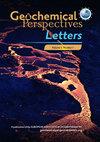A global imbalance in potassium and barium river export: the result of biological uptake?
IF 3.7
1区 地球科学
Q1 GEOCHEMISTRY & GEOPHYSICS
引用次数: 3
Abstract
The role of biological cycling on the chemistry of rivers remains poorly understood. In an attempt to close this knowledge gap, here we examine the difference between the elemental supply to catchments through rock degradation and the corresponding elemental riverine export, for two non-nutrient elements lithium (Li) and sodium (Na) and two nutrients-like elements potassium (K) and barium (Ba), in 20 of the largest world river catchments. Overall, the riverine export of K and Ba are lower than their estimated release by catchment scale rock degradation, while the two fluxes match for Li and Na. Barium isotope constraints lending support to this observation, we take this difference between these two element groups as a suggestion of the influence of biological uptake of rock-derived nutrients on river chemistry. Nevertheless, the magnitude of riverine K depletion cannot be reconciled with a pervasive growth of the biota on continents, nor with an “ occult ” export of organic material that would go unnoticed by common sampling protocols. One plausible explanation for this conundrum could lie in thecomplex partitioning of elementsamongst soil, biota, and dead organic matter. As a consequence, our study emphasises the need for further work aiming at deciphering the cycle of rock-derived nutrients in the Critical Zone. catchmentscalemass budgets,for X = Na, Li(non-nutrients) and fornutrient/nutrient-likeelements( X = K and Ba). This approach aims to quantify the catchment scale (im)balance between the supply of a rock-derived nutrient X through rock degradation ( D X ) and the summed dissolved and solid riverine export ( W X and E X , respectively). The difference in the “ solubility ” translates into a difference in the size of the W X and E X arrows.钾和钡河出口的全球失衡:生物吸收的结果?
生物循环对河流化学的作用仍然知之甚少。为了缩小这一知识差距,我们在这里研究了通过岩石降解向集水区提供的元素与相应的河流元素输出之间的差异,即在世界上20个最大的河流集水区中,两种非营养元素锂(Li)和钠(Na)以及两种营养元素钾(K)和钡(Ba)。总的来说,K和Ba在河流中的输出量低于其在集水区规模的岩石退化中的估计释放量,而这两种通量与Li和Na相匹配。钡同位素约束为这一观察提供了支持,我们认为这两种元素组之间的差异表明了岩石衍生营养物质的生物吸收对河流化学的影响。尽管如此,河流K的消耗程度与各大洲生物群的普遍增长不可调和,也与普通采样协议所忽视的有机物质的“神秘”出口不可调和。对这个难题的一个合理解释可能是土壤、生物群和死有机物中元素的复杂分配。因此,我们的研究强调了进一步工作的必要性,旨在破译临界区岩石衍生营养物质的循环。X=Na、Li(非营养素)和营养素/类似营养素元素(X=K和Ba)的流域尺度预算。该方法旨在量化通过岩石降解提供的岩石衍生营养物质X(DX)与溶解和固体河流出口总量(分别为WX和EX)之间的流域规模(im)平衡。“溶解度”的差异转化为W X和E X箭头大小的差异。
本文章由计算机程序翻译,如有差异,请以英文原文为准。
求助全文
约1分钟内获得全文
求助全文
来源期刊

Geochemical Perspectives Letters
Earth and Planetary Sciences-Geochemistry and Petrology
CiteScore
7.00
自引率
2.00%
发文量
42
审稿时长
15 weeks
期刊介绍:
Geochemical Perspectives Letters is an open access, internationally peer-reviewed journal of the European Association of Geochemistry (EAG) that publishes short, highest-quality articles spanning geochemical sciences. The journal aims at rapid publication of the most novel research in geochemistry with a focus on outstanding quality, international importance, originality, and stimulating new developments across the vast array of geochemical disciplines.
 求助内容:
求助内容: 应助结果提醒方式:
应助结果提醒方式:


